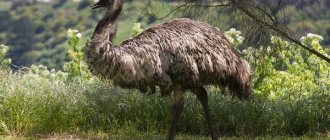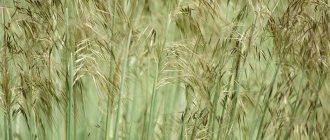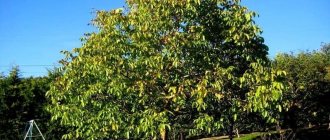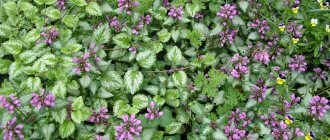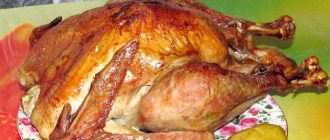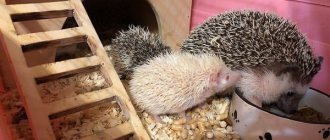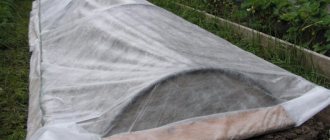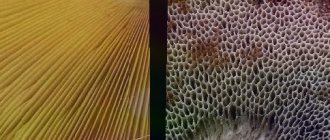The structure of the wasp sting and the degree of toxicity of the poison
The sting of a wasp looks like a sharp, thin needle. Upon closer inspection, you can see that the organ consists of two stylets, separated by a canal that is connected to the venom gland. In a calm state, the sting is located in the abdomen, where it is protected by special plates. Before the wasp stings, the sharp weapon is pulled out with the help of muscles, moving along a sled.
The composition, and therefore the toxicity of the poison, largely depends on the species of the stung insect. The most dangerous are the Asian giant hornets. But the bite of Scolia, despite its large size and threatening appearance, does not threaten human health. Considering that only female wasps have a sting, a meeting with a male is unlikely to be dangerous.
wasp sting
Differences in insect flight
These insects even fly differently.
The movements of the wasp are sharp, they can hang in the air for some time. They move from one place to another with lightning speed. Often during a flight you can observe chaotic, sudden movements. The exception is large wasps (hornets, scolias), they move more slowly.
The flight of a bee is somewhat calmer and more measured. They are not characterized by sudden movements; they try to land as quickly as possible. They do not create an annoying buzzing sound.
The bumblebee flies slowly, heavily, with a noticeable hum. From an aerodynamic point of view, a bumblebee should not fly at all. But the bumblebees were not told about this, so every morning they fly out to do their business.
Clarification: Physicist Jane Wang from Cornell University (USA) proved that the flight of insects does not violate physical laws, and finally dispelled the old myth that bumblebees cannot fly .
Here's another cool video of insects flying. It shows the moments of take-off in slow motion. Very interesting.
Functions of the sting and features of bee venom
Bees initially had no sting and appeared in the process of evolution. Since this is a modified ovipositor, only females have it. A bee's sting looks like a sharp dark needle. If you look at it under a microscope, you can see numerous notches covering the surface.
The main purpose of the sting is to protect the life of the bee, its home and the lives of other family members. The structure of the sting makes it easier to insert it into the victim’s body and inject poison from a special reservoir.
Main differences
These insects lead completely different lifestyles. A bee is always equated with useful and hardworking insects. Their families are raised in apiaries. Wasps are generally considered useless. In some cases, they are considered pests and their nests on the site are destroyed.
Bee and wasp
The first difference between a wasp and a bee is their origin. They belong to different orders, bees are Hymenoptera, wasps do not have a separate order. They belong to the suborder Stalked-bellied, adjacent to bees and ants. Therefore, wasps are similar in body shape to an ant and in color to a bee.
The bee colony is divided into 3 groups: the queen, worker bees and drones. The center of the family is the queen, around whom all the other bees work. Bees have a triangular head with compound eyes. A worker bee has 4000-5000 facets, a drone has 6000-8000, and a queen has about 5000. Simple eyes are located in the parietal zone. On the median seam of the head there is a kind of “third” eye. This structure allows you to collect and transform information in a special way.
The wasp has 2 large compound eyes located on the sides. Therefore, she sees in different directions at the same time. Below in the front of the muzzle there is a forehead with a pair of segmented whiskers. These antennae contain olfactory organs that help navigate space in the dark. The antennae allow the wasp to evaluate the parameters of humidity, temperature and gas pollution in the nest.
The bee's mouth has an upper and lower lip and jaws, as well as a proboscis for collecting nectar. The wasp's mouth primarily serves to grind plant fibers, which it uses for food and for building a nest.
The productivity of a bee colony depends on the number of offspring. On average, one family collects 10-12 kg of honey per season. The speed of a loaded bee is 30-340 km/h. One bee makes 26 flights per day. The average weight of an adult bee is 120 mg. Autumn bees live about 32 weeks, summer bees only 6 weeks. Bees navigate by the sun and also remember the landscape. At night they find their way thanks to their senses of smell and touch.
Wasps are divided into solitary and social. Single birds do not create nests. The female individual seeks food in the soil. These could be beetle larvae, which she paralyzes with poison. Then she lays eggs in them. If there are several larvae at once, the result is a honeycomb-like structure. Wasp larvae live and develop at the expense of insects paralyzed by the queen.
Bee family
Burrowing wasps make nests in plant stems, but are quite rare. Social wasps gather in colonies and build honeycomb houses, attaching them with a special leg to eaves, ceilings and tree branches. Colonies have 2 groups of wasps: queens, which lay eggs, and workers. The queen builds one cell and lays an egg there. Then a structure of other cells is built around this cell. The queen feeds the larvae. She chews the insects and gives them to the larva. They, in turn, produce saliva, which is taken by worker wasps. This procedure is called tropholaxis. During the growth process, the larva completely seals the cell, forming a cocoon. After maturation, an adult insect hatches from the cocoon, and the cocoon is prepared for the next larva. Individuals hatch at the end of summer. Part of the brood falls into torpor, waiting out the winter, while the other dies.
Difference between the sting of a worker bee and a queen bee
Of those who have a sting in a bee colony, in addition to worker bees, it is necessary to mention the queen. Since the queen, unlike sterile workers, uses the ovipositor for its intended purpose - to lay eggs, it is better developed and longer than that of ordinary bees. In addition, the queen's sting has only 3 serrations, so she can easily pull it out even from soft tissues.
Bee sting
Lifestyle
Insects also differ in their lifestyle:
- The flight of a bee is soft and leisurely. The nectar collector needs to visit many flowers without missing a single one. The wasp flies rapidly, at high speed, but can freeze in the air for a moment;
- All insects prefer to live in families, which mainly consist of ordinary workers, one queen and drones.
Domestication and Taming:
- Man made comfortable hives for domestic bees. Working individuals produce wax from which they build honeycombs;
- Wild individuals make their nests in tree cavities and mountain crevices.
Wasps also live in groups, where responsibilities are clearly distributed between them. Sometimes they prefer to live as hermits. Their nest is round, as if made of thin crumpled paper. In fact, they prepare it from rotten wood and dry plants.
Dirt and small debris are used to build the nest. They attach their nests to the walls of a house, large tree branches, thick grass, even in a thick plant stem, a discarded mitten, or a piece of cardboard.
How does a bee sting?
The bee sting process occurs in several stages:
- The insect comes into contact with the surface of the enemy's skin. Under the influence of the abdominal muscles, the tip of the sting, hidden in the abdomen, is directed to the exit hole.
- The bee's stinger extends outward and the insect plunges it into the skin of the victim.
- When the tool sinks at least a third, the bee can no longer pull it out; the notches interfere with this. After the insect stings, it tries to fly away, resulting in part of the abdomen being torn off.
Despite the fact that the bee has already flown away, the poison continues to enter the stung person’s body for some time through the sting remaining in the skin.
Behavior
Families of these individuals can consist of several thousand individuals. The construction of a wasp's nest begins with the queen. It is the queen who begins to build the first layer of the nest and subsequent ones. After the construction of the house has begun, she mates with the drone, lays larvae and feeds the offspring.
The queen larvae are laid in early summer, and sterile individuals emerge from these offspring. Already at the beginning of the period, these young individuals are ready to mate and reproduce. The development of young insects occurs in a cell built by the queen, where she feeds them with various insects, which she immobilizes in advance.
Wasps can lay larvae directly in the body of large beetles. As these insects develop, their status also increases. The lowest rank is assigned to cleaning the nest, the highest is to obtain food. With the arrival of spring and cold weather, all drones and drones freeze, only the queen survives.
A bee swarm, as in the previous case, has individuals with divided responsibilities. Some bring nectar to the hive, others put it in honeycombs, others do the cleaning, clearing the hive of dead individuals. The hive also has guards, insects are at the entrance and make sure that strangers do not enter, there are also those who clean the cells, there are guards and those who care for the offspring.
During its life, each individual goes through all of the above work, as it is designed by nature. It all starts with cleaning the honeycombs, then the young individual begins to produce milk, and she begins to feed the young with eggs, and also feeds the mother, after which she begins to feed the older generation with beebread. The next stage is the placement of nectar into cells, which is brought by the collectors.
Afterwards, he removes the trash. When the wax glands begin to work, it is engaged in construction. After 18 days, the insect can produce poison, which gives them the right to protect the house. For the winter period, the bee colony accumulates special reserves of beebread; if there is not enough food in the fall, they destroy the drones. For the mating process, the queen flies out of the hive, which makes it possible to find a more viable male, perhaps not from her own hive.
Does a bee leave a sting when it stings?
Taking into account the external similarity of insects, for many people the question remains open: who leaves the sting - a wasp or a bee. The bee's sting is saw-shaped due to numerous barbs radiating from the sharp end to the base, like a fishhook. It is these notches that prevent the sting from being removed after it penetrates the skin.
Trying to fly away, the insect twitches and tears out from its body not only the sting, but also part of the abdomen with a sac of poison and internal organs.
How to properly remove a sting?
When helping a person after an insect bite, the first step is to carefully examine the wound and remove the sting. If in the case of wasps this action is most often skipped, since the sting rarely remains in the skin, then in the case of a bee sting, the sting must be pulled out as quickly as possible, since while it is in the skin, poison continues to enter the body.
You must act confidently and carefully. The most convenient way is to use tweezers. They grab the sting at the base and pull it towards themselves. If you don’t have tweezers, a needle will do, which should act in the same way as when removing a splinter. Under no circumstances should you try to squeeze out the sting. This will provoke a more active spread of the poison.
Removal
After the sharp instrument is removed, the wound is washed and treated with a disinfectant. A cold compress is applied to relieve swelling.
Relation to the uterus
The bee colony honors and cares for its queen. They get her food, surround her with a retinue, and in case of danger they all protect her. She is in the hive all the time and leaves it only to mate; during this period it is time for the family to separate. But the wasp family shows absolutely no concern for its queen; it exists on its own and obtains food on its own.
Do all bees sting?
Not all bees are capable of stinging. Drones have a physiological obstacle - they do not have a stinger. Since this is a modified ovipositor, which is not provided by nature for male bees. Yes, and not every bee with a stinger can sting.
On a note! Working individuals, whose crops are filled with honey, are not able to bend their abdomen at the required angle in order to extend the sting and put it to work.
Experienced beekeepers can protect themselves by artificially creating a situation in which the bee fills the crop with honey. Bees perceive fumigation of the hive as an alarm signal. Fleeing from the fire, they gather supplies so as not to starve until new housing is found.
Structure
- Bee. The body consists of a head, which has a triangular shape, the eyes are separated by a seam. The abdomen on which the sting is located. Breast and chitinous layer. They have two pairs of wings, 12 legs, on which special baskets are placed for collecting pollen. There is a special proboscis for collecting nectar. In an ordinary individual, the eye contains up to five thousand facets, in the queen there are even more, and in the drone up to eight thousand.
- Wasp. These individuals can look both left and right at the same time, thanks to the eyes that are located on both sides of the head. On the forehead under the eyes there are some kind of antennas that help them detect food, measure humidity, temperature, and carbon dioxide. These insects have 6 legs, which are located at the bottom of the abdomen.
Causes of wasp and bee stings
Despite the fact that wasps are considered much more aggressive insects than bees, neither one nor the other almost never attacks people without a reason. They may attack if they feel threatened or are defending the nest.
Factors provoking insect attacks:
- sudden movements made near them;
- an attempt to stir up or destroy the home of insects;
- some odors (alcohol, perfume, sweat);
- colors are too bright or dark;
- loose hair, fur elements on clothes.
Nest
Another reason for bee attacks is the smell of fresh poison. If an insect stings, then there is a high probability that its relatives will soon appear. With wasps the situation is somewhat different. Sensing danger, they release a special alarm pheromone, which attracts nearby wasps.
Differences between a wasp sting and a bee sting
Both bees and wasps have well-developed jaws. However, when we talk about a human bite, we mean a sting. When attacking people, these insects very rarely use their jaws; usually the sting acts as a weapon.
It is quite difficult to distinguish from the first sensations which insect has stung. It is believed that a wasp sting is more painful, but, firstly, the intensity of pain can only be compared if a person was stung by both insects at the same time. And secondly, perception depends on the individual characteristics of a person, age and type of insect, so it is definitely wrong to give the palm to someone else.
It is also not easy to determine which stinging insect attacked from the symptoms. The signs of a bite are the same - burning pain, redness of the skin, swelling. The only true difference is the presence of a sting in the wound; in a bee it always comes off, unlike a wasp.
Nutritional Features
The bee is a true vegetarian and collects only nectar and pollen from flowers. Her nutritional principles are shared by bumblebee, a fellow connoisseur of flower products.
But wasps and hornets are avid hunters and predators. The protein menu is necessary for the larvae, so the workers attack small insects, sometimes even larger than them. Often their prey is a bee or a fly. To immobilize the victim, wasps do not always use their main weapon - the sting.
They successfully cope with weak opponents with the help of powerful jaws. Each species has its own strategy and tactics of attack, but in most cases they drag their prey into the nest, riding it on horseback.
Wasps clinging to a piece of meat, fish, or a fallen animal are a common occurrence. With their powerful jaws, they bite off tiny pieces of meat and bring them to the larvae in a chewed state.
With great enthusiasm, wasps and hornets eat fermented or fresh fruits, sugar-containing foods, sweet drinks and even beer.
